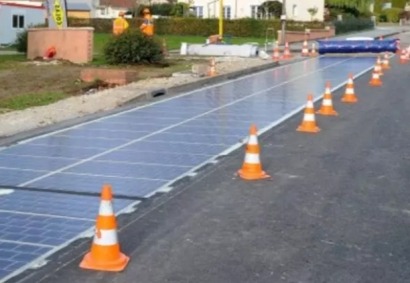
The expansion of rooftop solar panels has proven critical in the fight against climate change. While producing zero emissions to help offset global warming, this renewable technology has been at the forefront of a new concept: highway solar roofs. Although in their infancy, highway solar roofs have the potential to combat CO2 emissions and decrease road accidents.
Benefits of Roofing Highways With Solar Panels
Highways produce ample greenhouse gasses. Aside from vehicles, road infrastructure — materials production and transport, construction and maintenance — account for 5%-25% of CO2 emissions.
Roadway accidents are also prevalent, claiming 1.19 million lives worldwide each year. Of the 60,904 U.S. motor vehicle fatalities in 2021, about 1,584 occurred from glare, lights, snow, rain and other obstructions, with some slight variation.
Highway solar roofs would be installed on overpasses, tunnels, sound barriers and road surfaces. They would reduce CO2 emissions and enhance road safety by creating renewable energy and improving transportation infrastructure.
According to a recent study, highway PV panels could sequester 28.78% of global road-based CO2 and avert 150,000 fatal car crashes, relieving the associated socio-economic burdens. They could also help nearby communities generate a clean energy source to power their homes and businesses.
Feasibility and Design of Highway Solar Roofs
The cost of residential solar panels has rapidly decreased by 50% over the past 10 years, from $50,000 to $25,000. This is due to lower material costs and more efficient installation, labor and permitting. Beyond the residential panels, clean energy has seen a massive drop in the past few decades, too. Solar photovoltaic costs have reduced by 90% and batteries by more than 90%.
Also, because today’s PV panels have enhanced durability, these renewable components extend the longevity of rooftops and other surfaces they are mounted on, preventing premature aging of materials — a positive output for preserving the integrity of highway infrastructure and coverings.
Engineers must take much into consideration before implementing highway solar roofs, including the following:
Researchers have also considered the shape of highway solar roofs, such as flat roofs, inclined pent roofs, gabled roofs or arched cross-sections. Flat roofs present drainage challenges, while arched roofs have lower efficiency yields and manufacturing costs. Depending on the direction of traffic, pent or gable roofs are most suitable.
Case Studies of Project Implementation
Numerous highway solar pilot projects have been conducted worldwide, some more successful than others. However, every case has helped engineers inch closer to understanding the potential of solar roofs on roadways.
Wattway Project in France
The Wattway project in France has been deemed an engineering flop. In December 2016, the country opened a 0.5-mile stretch of highway with 31,000 square feet of PV panels. Building the road cost $5.2 million, and experts expected it to generate enough electricity for nearby streetlights.
However, by 2018, 295 feet had to be ripped up from significant wear and tear. Many also complained about noise levels when driving on it, causing officials to lower the speed limit. Also, it hadn’t produced nearly as much solar energy as engineers had hoped.
Solar Highways in the U.S.
States nationwide have explored solar projects on highways. For example, a new bill proposal in California would allow utility companies and developers to access 15,000 miles of highway roads for solar panels, battery storage and new transmission lines. The bill would also propose financial incentives for schools and businesses to install solar canopies over parking lots.
Oregon was the first state to construct a solar highway of 600 panels in 2008. Georgia, Massachusetts and Washington have followed suit.
In New England, officials are gearing up to build solar farms along the Maine Turnpike near Augusta. The state predicts they’ll power over 1,000 homes and save $7 million in electricity costs over two decades.
Challenges and Considerations for the Future
If executed correctly, highway solar roofs could be practical in achieving clean energy. Of course, this will require engineers to address the challenges while governments, developers, technicians, and scientists coordinate closely on projects.
Consider how a utility-scale solar power plant requires 5-7 acres per megawatt of electricity generation. Its development entails clearing vegetation and grading the land for sufficient PV installation. Sadly, this impacts wildlife habitats and ecosystems. Some studies have even explored bird collisions with PVs, as migrating avian species sometimes mistake the shiny panels for water.
Naturally, implementing highway solar roofs will be costly, and many places may not be interested in footing the upfront investments. Additionally, they will need to uncover how to store excess energy from solar arrays, connect it to a power line and distribute it. If there aren’t any power lines on the highway, engineers will need to build them.
Likewise, what happens to solar panels and power lines in hurricane-prone areas like Florida and the Gulf Coast? Colder climates may also endure problems from heavy wind and snow, similar to residential PV systems.
A solid design for highway solar roofs is the first step to harnessing the sun’s power, which engineers can determine through continued pilot projects. Utilizing grassy, flat median strips — otherwise rendered unusable — is another strategy they can assess to avoid taking up new land.
Technicians and conservationists should also collaborate on building wildlife crossings, preserving natural vegetation, and using sustainable construction practices and materials to limit environmental impacts.
Envisioning a Safe and Renewable Highway
Could the world eventually see highway solar roofs? Considering the strides PV panels have made in the last decade, anything is possible. The actual test will be whether experts can overcome the technical, financial and environmental challenges of such an undertaking. With continued assessment through smaller-scale projects and new technologies, engineers are bound to discover its widespread feasibility.

